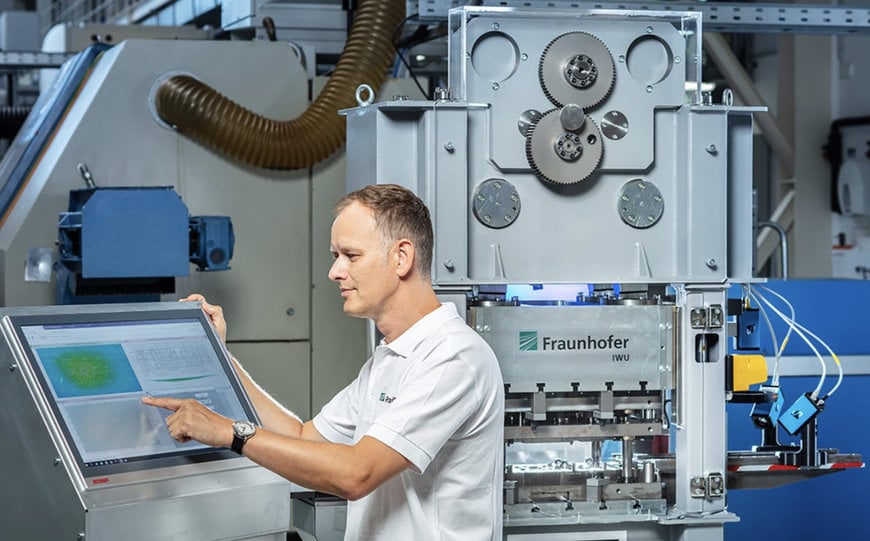www.industryemea.com
06
'22
Written on Modified on
FRAUNHOFER COGNITIVE T-SLOT SENSOR CONCEPT: INCREASING FORMING MACHINE EFFICIENCY WITH COGNITIVE TRANSFORMATION OF INDUSTRIAL PROCESSES
Forming presses are widely used as key elements of industrial production processes. From automotive technology to refrigerators, almost every product we encounter contains formed parts. The purchasing costs of these machines can reach double-digit millions, and it takes a great deal of time to set up and adjust precisely as needed. Given such a high level of investment, buyers expect machinery of this kind to keep running efficiently for a long time without any loss in quality.

During operation, forming presses create vast quantities of data that are captured and stored automatically – covering everything from process information (including the forming force or the number of strokes) and quality specifications to status-related data and process variables (such as the service life). To date, machine users have in most cases only been able to collect this data at the machine itself: It has not been possible for them to gain aggregated stocks of data from machine pools or to share it with stakeholders such as manufacturers or suppliers. Additionally, previous solutions have rarely provided structured analysis, evaluation and application options for data. They have not incorporated concepts and technology for closed data life cycles in which data can be sustainably processed, retrieved and easily distributed as a way of generating new findings. In short, there has been a lack of cognitive internet technologies.
Cognitive T-slot
At the Hannover Messe 2022, Fraunhofer CCIT will use forming machines as an example for showcasing a solution in which cognitive internet technologies ensure consistently transparent processes and, as a result, enhance overall equipment effectiveness. At the heart of this new technology is smartNOTCH, a cognitive T-slot that continually monitors production processes with automated methods. The new sensor concept can be integrated into the interior of a forming press easily and with flexibility – and once installed, it is able to measure deformations and loads at interfaces with tools as well as transfer data to evaluation systems wirelessly. “The technology enables continuous monitoring that can be used inline for wear detection, protection, acceptance and tool integration. This makes it possible to streamline workflows and make processes more agile,” says Robin Kurth, Head of Group Forming Machines at Fraunhofer CCIT.
Usage conditions can be attached to the data obtained through smartNOTCH, giving machine users the ability to decide who they want to share forming press data with, for what purpose and under what conditions. In this context, intelligent, secure and standardized edge devices provide the necessary interfaces for networked processing chains that straddle regional, national or international company boundaries. When data sovereignty is assured, and intellectual property (IP) along with it, data silos can be compiled. Users, manufacturers and suppliers of forming machines can then apply machine learning (ML) and artificial intelligence (AI) methods to the aggregated data, giving rise to new insights into the performance and error susceptibility of the machines. When developing a suitable analysis algorithm, the experience acquired by specialist employees throughout the long service life of a forming machine can provide additional input. Fraunhofer CCIT’s informed machine learning approach makes it possible to integrate this information.
Using data and creating new insights
The solution provides users, manufacturers and suppliers with precisely the information they need to increase the efficiency of forming machines – whenever they need it. This makes it possible to start up new machines and processes more quickly, test out new pressing tools with more specific aims in mind and perform preventive maintenance on presses, for example. Intelligent capturing, secure sharing and systematic evaluation of data can also allow new business models to emerge, enabling manufacturers and suppliers, for example, to provide their customers with not only hardware, but also smart services based on data. Examples include the remote operation of entire machines (Equipment-as-a-Service/EaaS) and targeted upgrading and modernization (retrofitting) of existing presses.
The Hannover Messe exhibit will put the smartNOTCH at the forefront: A forming press demonstrator provides visitors with live insights into how a cognitive T-slot works.
www.fraunhofer.com

